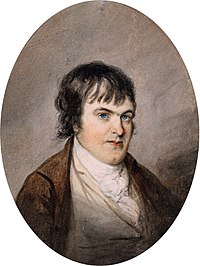John Glover | |
|---|---|
 John Glover | |
| Born | 18 February 1767 Houghton on the Hill, Leicestershire, England |
| Died | 9 December 1849 (aged 82) |
| Nationality | British |
| Education | Free School, Appleby |
| Known for | Landscape |
| Notable work | 'Hobart Town, taken from the garden where I lived', 1832[1] 'Mount Wellington and Hobart Town from Kangaroo Point' 1831–33[2] 'Natives on the Ouse River, Van Diemen's Land', 1838[3] 'Natives at a corrobory, under the wild woods of the Country [River Jordan below Brighton, Tasmania]', ca. 1835[4] 'A view of the artist's house and garden, in Mill's Plains, Van Diemen's Land', 1835[5] |
| Movement | Claudean style, picturesque |
| Spouse | Sarah |
| Awards | Louis XVIII gold medal (for 'Bay of Naples') |
John Glover RBA (18 February 1767 – 9 December 1849) was an English-born artist. In later life he migrated to Van Diemen’s Land and became a pastoralist during the early colonial period. He has been dubbed "the father of Australian landscape painting."[6]
- ^ "Hobart Town, taken from the garden where I lived, 1832". State Library of New South Wales. Retrieved 10 December 2017.
- ^ "Mount Wellington and Hobart Town from Kangaroo Point, 1831-33". National Gallery of Australia. Retrieved 12 March 2015.
- ^ "Natives on the Ouse River, Van Diemen's Land, 1838". Art Gallery of New South Wales. Retrieved 12 March 2015.
- ^ "Natives at a corrobory, under the wild woods of the Country [River Jordan below Brighton, Tasmania], ca. 1835". State Library of New South Wales. Retrieved 12 March 2015.
- ^ "A view of the artist's house and garden, in Mill's Plains, Van Diemen's Land, 1835". Google Art Project. Retrieved 12 March 2015.
- ^ Alvaro, Alexandra (24 June 2021). "John Glover sketchbook fetches 20 times estimated price at auction". ABC News. Retrieved 24 June 2021.